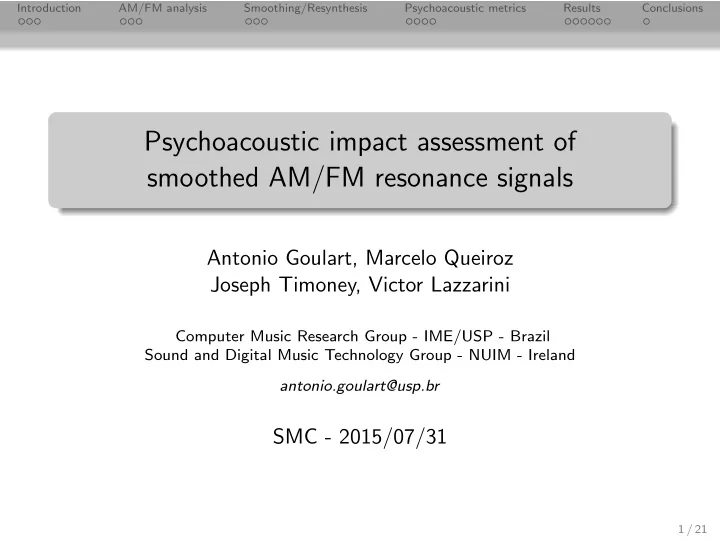

Introduction AM/FM analysis Smoothing/Resynthesis Psychoacoustic metrics Results Conclusions Psychoacoustic impact assessment of smoothed AM/FM resonance signals Antonio Goulart, Marcelo Queiroz Joseph Timoney, Victor Lazzarini Computer Music Research Group - IME/USP - Brazil Sound and Digital Music Technology Group - NUIM - Ireland antonio.goulart@usp.br SMC - 2015/07/31 1 / 21
Introduction AM/FM analysis Smoothing/Resynthesis Psychoacoustic metrics Results Conclusions Resonance tendency of a system to vibrate sympathetically at a particular frequency in response to energy induced at that frequency. FOF, VOSIM, ModFM, Phase distortion Analysis/resynthesis 2 / 21
Introduction AM/FM analysis Smoothing/Resynthesis Psychoacoustic metrics Results Conclusions TB-303 Resonance Env Mod Decay Label 60% max min A 60% max 60% B max 75% 25% C max 75% 75% D 3 / 21
Introduction AM/FM analysis Smoothing/Resynthesis Psychoacoustic metrics Results Conclusions Waveform D 4 / 21
Introduction AM/FM analysis Smoothing/Resynthesis Psychoacoustic metrics Results Conclusions x ( t ) = a ( t ) cos ( θ ( t )) ˙ θ ( t ) = f ( t ), instantaneous frequency = > fits locally a ( t ), instantaneous amplitude various techniques Hilbert Transform x ( t ) = x ( t ) ∗ 1 ˆ π t 90 ◦ phase shift = > analytic signal x ( t ) = | z ( t ) | e j θ ( t ) z ( t ) = x ( t ) + j ˆ resynthesis �� t � ˆ y ( t ) = ˆ a ( t ) cos f ( τ ) d τ −∞ 5 / 21
Introduction AM/FM analysis Smoothing/Resynthesis Psychoacoustic metrics Results Conclusions Decomposition - Waveform D - AM portion 6 / 21
Introduction AM/FM analysis Smoothing/Resynthesis Psychoacoustic metrics Results Conclusions Decomposition - Waveform D - FM portion 7 / 21
Introduction AM/FM analysis Smoothing/Resynthesis Psychoacoustic metrics Results Conclusions Boxcar window Hanning window 20 and 100 samples long window w ( t ) �� t � (ˆ y ( t ) = (ˆ a ∗ w )( t ) cos f ∗ w )( τ ) d τ −∞ 8 / 21
Introduction AM/FM analysis Smoothing/Resynthesis Psychoacoustic metrics Results Conclusions Comparison - AM portion - Smoothing with Boxcar 20 9 / 21
Introduction AM/FM analysis Smoothing/Resynthesis Psychoacoustic metrics Results Conclusions Comparison - FM portion - Smoothing with Boxcar 20 10 / 21
Introduction AM/FM analysis Smoothing/Resynthesis Psychoacoustic metrics Results Conclusions Brightness center of gravity of the spectrum related to the most prominent portion of a spectrum (specially with resonant sounds) usually the metric that presents larger variations N � ka k k =1 Br = N � a k k =1 11 / 21
Introduction AM/FM analysis Smoothing/Resynthesis Psychoacoustic metrics Results Conclusions Tristimulus introduced as a timbre equivalent to the color attributes in vision a 1 T r 1 = N � a k k =1 T r 2 = ( a 2 + a 3 + a 4 ) N � a k k =1 N � a k k =5 T r 3 = N � a k k =1 related to the warmth (3.5) 12 / 21
Introduction AM/FM analysis Smoothing/Resynthesis Psychoacoustic metrics Results Conclusions Tristimulus T r 1 + T r 2 + T r 3 = 1 close to origin = > strong fundamental close to right corner = > strong high partials close to up corner = > strong mid-range partials 13 / 21
Introduction AM/FM analysis Smoothing/Resynthesis Psychoacoustic metrics Results Conclusions Irregularity jaggedness, ripples N � ( a k − a k +1 ) 2 k =1 Ir = , a N +1 = 0 N � a 2 k k =1 square, clarinet = > max irregularity = > hollow sound impulse train = > zero irregularity = > buzz 14 / 21
Introduction AM/FM analysis Smoothing/Resynthesis Psychoacoustic metrics Results Conclusions Brightness Waveform A and C - AM/FM smoothing 15 / 21
Introduction AM/FM analysis Smoothing/Resynthesis Psychoacoustic metrics Results Conclusions Brightness Waveform A - AM-only and FM-only smoothing 16 / 21
Introduction AM/FM analysis Smoothing/Resynthesis Psychoacoustic metrics Results Conclusions Tristimulus Waveform A and C - AM/FM smoothing 17 / 21
Introduction AM/FM analysis Smoothing/Resynthesis Psychoacoustic metrics Results Conclusions Tristimulus Waveform A - AM-only and FM-only smoothing 18 / 21
Introduction AM/FM analysis Smoothing/Resynthesis Psychoacoustic metrics Results Conclusions Irregularity Waveform A and C - AM/FM smoothing 19 / 21
Introduction AM/FM analysis Smoothing/Resynthesis Psychoacoustic metrics Results Conclusions Irregularity Waveform A - AM-only and FM-only smoothing 20 / 21
Introduction AM/FM analysis Smoothing/Resynthesis Psychoacoustic metrics Results Conclusions brightness/tristimulus point of view, not effective to smooth signals with strong resonance (although it certainly changes the sound) tristimulus more affected by smoothing the FM component irregularity more affected by smoothing the AM component more irregular input = > more similar perceptual outcome interesting variations when processing modest and mild resonances longer smoothers = > less artifacts Hanning smoothers = > less artifacts suite of AM/FM effects Thanks a lot! antonio.goulart@usp.br 21 / 21
Recommend
More recommend